Low-Water Use Trees
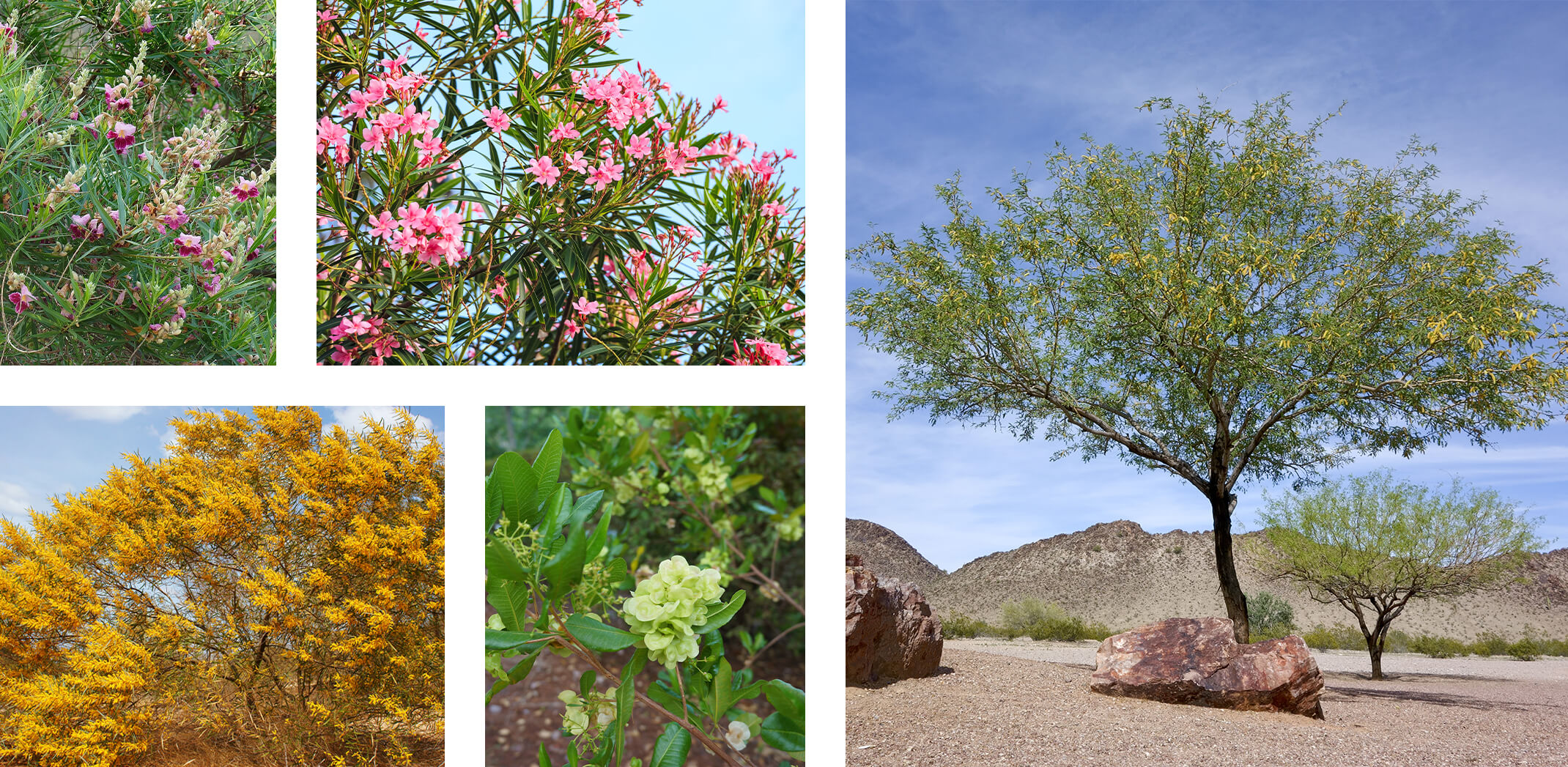
Trees Designed for Desert Life
Once established, the following tree varieties require minimal water to grow and thrive in your desert garden landscape. To learn how to ensure your trees develop a strong root system, refer to our New Plant Watering Guide.
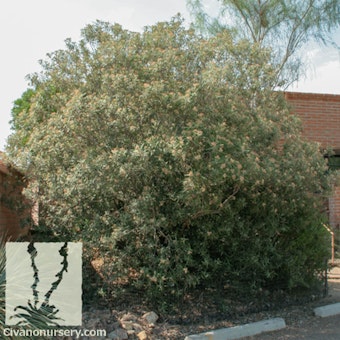
Arizona Rosewood
Vauquelinia californica is excellent for use in Xeriscapes, as a background or screen, an informal hedge, accent and more.
- Form: This evergreen shrub grows slightly stiff and brittle
- Growth Habit: Slow to moderately growing to 10 to rarely 25 feet tall (can be kept at 6-8 feet if desired with proper water and pruning). Size influenced by supplemental watering.
- Foliage & Trunk: Medium to Dark dull green foliage, and gray stems
- Flowers & Fruits: Persistent white flowers followed by small brown fruit—from April to May
- Temperature: Tolerant of all temperatures below 110oF (folliage begins to yellow in extreme heat)
- Light: Partial to full sun; only moderatley tolerant of reflective heat and western exposures in the low desert
- Soil: Prefers well-drained soil
- Watering: Requires infrequent, deep supplemental watering in summer
- Pruning: Lightly prune to shape only (do not shear)
- Photo: Courtesy Civano Nursery
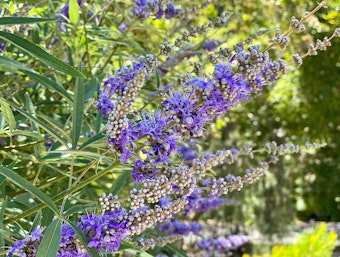
Chaste Tree
Because of its unique early summer flowers, the Lilac Chaste tree (Vitex agnus-castus) is excellent for use as a large background accent shrub or as a small, multiple-trunk accent shade tree in mesic or oasis landscape designs.
- Form & Character: This upright, arching and spreading tree has a winter deciduous habit
- Growth Habit: Moderatley fast growing to 20 feet tall and wide. Growth rate and flowers impacted by moisture availability.
- Foliage: Dull green leaves that can turn golden yellow in late winter (winter color varies from year to year)
- Flowers & Fruits: Terminal spikes of intense white to violet blue flower plumes that attract bees. Fruits are small brown seed capsules that are persistent through the winter months
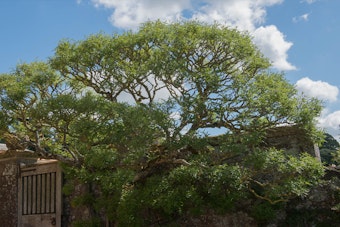
- Temperature: Summer heat is required for the best flowering
- Light: Full Sun
- Soil: Tolerant of alkalline soil
- Watering: Requires regular, deep but infrequent watering from April to October, but little to no water the rest of the year. The more water, the faster it will grow, but the fewer the flowers.
- Pruning: Canopy can be trained to grow many different ways and to desired height. Pruning recommended while dormant—from December to early March.
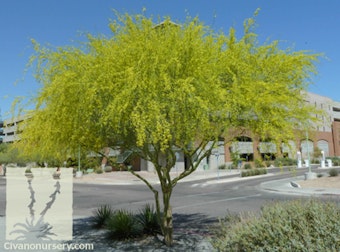
Desert Museum Palo Verde
This thornless, upright deciduous shade tree (Cercidium x 'Desert Museum') boasts long-lasting vibrant yellow blooms, is native to the Sonoran Desert and Arizona's official state tree! Great for firescaping or as a specimen or accent tree.
- Growth Habit: Quickly grows to 25 feet tall and wide
- Foliage & Trunk: Green foliage with a trunk and stems that remain green year-round
- Flowers & Fruits: Showy yellow flowers that bloom in spring, and may re-bloom in summer with supplemental watering; produces very few seedpods
- Temperature: Cold Hary Zones 8-9
- Light: Full Sun
- Soil: Prefers well-drained soil, and grows best with tree and shrub food
- Watering: Once established, requires only occasional watering and is drought tolerant
- Pruning: After flowering, prune for shape and structure
- Photo: Courtesy Civano Nursery
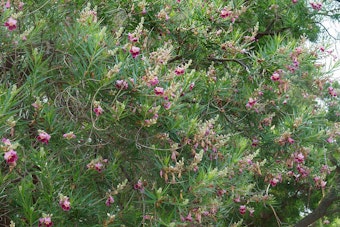
Desert Willow
This deciduous accent tree (Chilopsis linearis) attracts birds in summer and has many local varieties, some single trunk and others multiple trunk.
- Form & Attributes: This woody, open and airy tree perennial can maintain its leaves up to 6 months (November to April), and is colorful during the summer. Displays woody, brittle sticks, and seeds in winter.
- Growth Habit: Vigorously upright to weeting to 15-35 feet tall, with equal or greater width.
- Foliage & Trunk: Pale to bright green leaves, and shaggy bark
- Flowers & Fruits: Trumpet-shaped flower color varies by variety - petals range from white to pink to deep lavender and are lightly fragrant; long fruits are messy in summer and produce seeds
- Temperature: Tolerant of a range of temperatures
- Light: Full Sun
- Soil: Tolerant of a variety of soils
- Watering: For best growth and dense foliage, requires supplemental watering in summer
- Pruning: Selectively prune to improve appearance
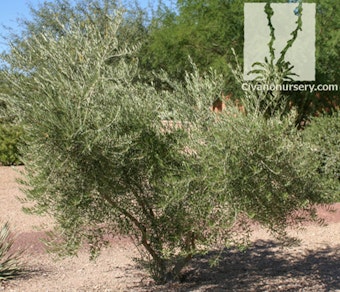
Fruitless Olive
The Fruitless Olive (Olea europaea - fruitless variety) makes an excellent choice for a xeric, Mediterranean or oasis theme landscape in the Arizona desert.
- Form & Character: This woody, rugged tree is naturally round and shaggy
- Growth Habit: This evergreen, perennial tree slowly grows to 25 to 30 feet tall and nearly as wide.
- Foliage: The leaves are small, and gray-green on top and silverly white on the bottom. Leaves create a cloud-shaped canopy that casts deep to filtered shade
- Flowers: This fruitless variety produces flowers; however, since they are imperfect and not designed to aid in the production of fruit, they release little to no pollen
- Trunk: As it matures its grey trunk will become gnarled and knotted
- Temperature: Heat-loving, and cold-hardy to 15oF
- Light: Full sun
- Soil: Tolerant of alkaline soil
- Pruning: Depending on how manicured you prefer your tree to be, regular removal of basal trunk suckers and water sprouts, crossing branches and misdirected limbs may be needed. Prune for desired shape, and crown raising and thinning as desired.
- Photo: Courtesy Civano Nursery
Green Hopseed Bush
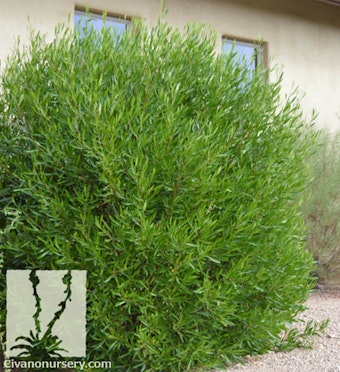 The Green Hopeseed Bush (Dodonaea viscosa) can be grown as a formal or informal hedge, multiple trunk small tree, a screen or accent.
The Green Hopeseed Bush (Dodonaea viscosa) can be grown as a formal or informal hedge, multiple trunk small tree, a screen or accent.
- Form & Attributes: Can be grown as an evergreen shrub or as a small multiple-trunk tree
- Growth Habit: Can be grown as a perennial shrub to a small tree - moderate growth to 4 to 20 feet tall depending on frequency of watering and dryness of climate
- Foliage & Trunk: Has willow-like green leaves, and shredding rich, dark cinnamon brown bark. Some varieties have purple foliage in winter.
- Flowers & Fruits: Can be either male or female; female plants produce small fruits that look like Chinese lanterns that are light green at first and then fade to pink. Seed pods have several small rounded black seeds.
- Temperature: Tolerant of a range of temperatures
- Light: Full Sun; shade intolerant
- Soil: Tolerant of fast-draining soils; does not want to be chronically wet
- Watering: Watering greatly influences size; Water more for tree, little to no water for a small shrub
- Pruning: Minimal to influence shape
- Photo: Courtesy of Civano Nursery
Ironwood
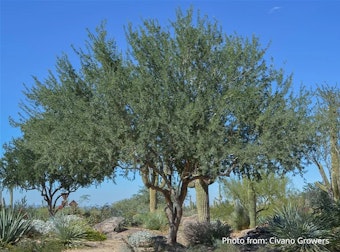
The Ironwood tree (Olneya tesota) is native to the lower Sonoran Desert and makes a great accent tree or light shade tree in any desert garden or landscape.
- Form: This rugged and twisting tree is briefly deciduous and grows in an upright, irregular form
- Growth Habit: This woody, semi-evergreen perennial tree has a medium growth rate to 30 feet tall and wide, depending on irrigation.
- Foliage: Has small, gray-green leaves
- Flowers & Fruits: Pale purple rose to lavender flowers in 2-inch long raceme appear April through May; pod fruits 2-3 inches long and black seeds that shed in August.
- Temperature: Tolerant of a wide range of temperatures
- Light: Full sun
- Soil: Tolerant of a variety of soil types
- Watering: Requires no water to occassional summer watering to encourage strength and hardiness. However, it looks best with occassional, deep watering in summer.
- Pruning: conservatively prune to shape, raise the crown, and remove occassional water sprouts and suckers
- Diseases and Pests: None
- Photo: Courtesy: Civano Growers
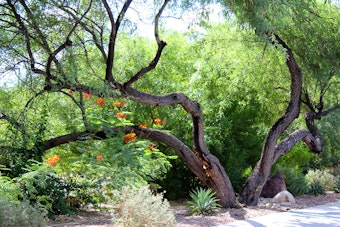
Mesquite
There are many varieties of Mesquite trees available. Some can be grown as a shrub, while others can grow to be trees over 50 ft. tall and 100 ft. wide. They prefer full sun. Once established, little to no water is required—depending on the variety.
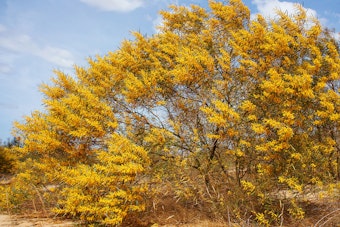
Mulga
Acacia aneura can be used as a single specimen or planted in groups. Can also be planted as an informal hedge, a screen or a large background tree.
- Form & Character: Very stiff and upright; rigid to spreading with age; brittle wood
- Growth Habit: This evergreen, woody perennial slowly grows to 20 to 30 feet tall and wide
- Foliage: Small grayish blue-green phyllodes that are initially bronzy-brown in color
- Flowers & Fruits: Primarily flowers in the fall and episodically during the warm season; rod-shaped flowers with yellow stamens; fruits in spring - small flattened pods that mature from green to brown
- Temperature: Heat-loving, and cold tolerant to 15oF
- Light: Full Sun
- Soil: Tolerant of most alkaline soils
- Watering: Once established, requires water only every one to two weeks during summer; additional watering will dramatically increase its growth rate and size. Drought and heat stree tolerant, once established.
- Pruning: Prune to shape as desired
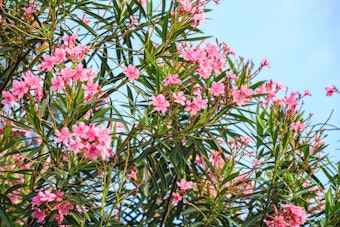
Oleander
This versatile evergreen shrub (Nerium oleander) can be grown as an accent, informal hedge, screen or as a tree, and is available in a wide number of cultivars/varieties.
- Form & Character: This stiff, colorful shrub can be grown low, rounded and mounding, to a strong, upright and open tree.
- Growth Habit: Moderate growing, vigor depends on variety - ranging from 4 to 25 feet tall.
- Foliage: Green with prominent light green mid vein
- Flowers & Fruits: Blooms range in color from white to pink, salmon to burgundy. The lighter the flower the more heat tolerant it is. Narrow, 5 inch long fruits, and seeds that are dispersed by the wind in fall and winter. Blooms profusely over a long period - from April to August.
- Temperature: Cold hardy to 15o to 20oF; thrives in the hot summer in the desert
- Light: Full sun (does not tolerate shade)
- Soil: Tolerates all but highly alkaline soils
- Watering: Drought tolerant, once established. Responds well to supplemental watering in warmer weather; no supplemental water is needed in winter.
- Pruning: Prune dwarf varieties if needed in late February to early March to desired height. For best results, prune large cultivars in late February or August for rapid regrowth. Can be severly pruned once every two to three years. Shearing is not recommended and can damage tree over time
- Learn more about safety concerns regarding this plant.
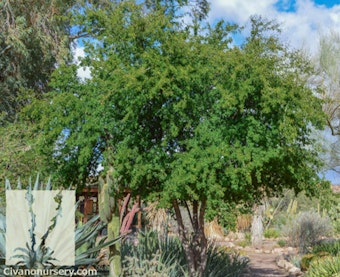
Texas Ebony
This slow-growing and eventually large, upright shade tree (Ebenopsis ebano) is excellent in large xeric and oasis landscape designs. The Texas Ebony also makes a wonderful bonsai tree.
- Form & Character: This stiff evergreen is briefly deciduous in late spring, followed by flowers if grown without irrigation; otherwise it is evergreen.
- Growth Habit: This woody perennial tree slowly grows to 40 ft. tall and wide, with multiple trunks. The bark is smooth when young and becomes rough and fissured with age.
- Foliage: Medium green small leaflets with stipular spines hidden underneath
- Flowers & Shrubs: Produces small, musty, cream-colored flowers in early summer that are very attractive to bees. Can flower again after monsoons in early fall. Fruits are persistent, very large, dark brown, and curved or contorted pods.
- Temperature: Tolerant of typical heat and cold in Phoenix, AZ. Sunscald is common on exposed southwestern sides of tree trunk. Will drop its leaves and go deciduous if air temperatures fall into the low 20oF. Will have stem dieback if temps fall below 20oF.
- Light: Full Sun
- Soil: Very tolerant of desert soils
- Watering: Very drought tolerant, once established. Growth rate can be increased by providing supplemental water to young specimens.
- Pruning: Crown raising may be desired given its dense native canopy. Sheering is not recommended.
- Photo: Courtesy of Civano Nursery
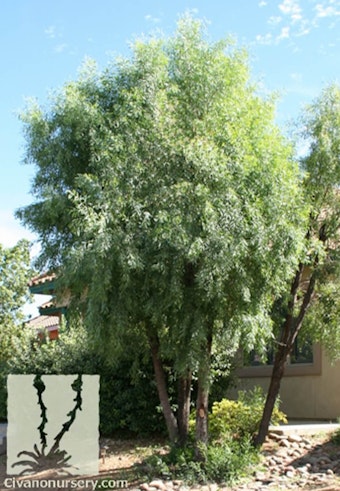
Willow Acacia
This upright accent tree (Acacia salicina) can occasionally grow with multiple trunks. Makes a great patio tree, screen or xeric accent.
- Form: Medium-size, weeping evergreen
- Growth Habit: Vigorous and fast growing vertical form up to 50 feet tall and under a 50 feet wide
- Foliage & Trunk: Phyllodes range in color from light gray-green to blue-green, trunk is grayish brown
- Flowers & Fruits: Blooms yellow-green to cream flowers, in late fall/early winter. Fruits are 1-5 inch-long pods
- Temperature: Heat-tolerant once established; cold hardy to 16oF
- Light: Full sun
- Soil: Tolerant of most local soils
- Watering: Infrequent, deep irrigations during summer. Does not require watering outside of the summer.
- Pruning: Pruning recommended to prevent damage from Monsoon winds, and for branches with excessively acute angles when young to avoid furture limb breakage
- Photo: Courtesy Civano Nursery
To Ensure the Success of Your New Tree
At SummerWinds, we have all the tools you need to plant your new tree—from soils and amendments, to fertilizers, stakes and more.
- To learn how to plant your tree, check out our How-to Video: How-To Plant a Tree
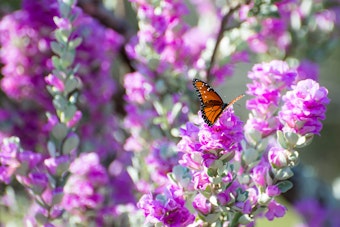 Looking for low-water use shrubs for your desert garden or low-water use houseplants? Check out these plants that thrive with little water: Learn More
Looking for low-water use shrubs for your desert garden or low-water use houseplants? Check out these plants that thrive with little water: Learn More
Learn how to establish a strong root system for your tree with our New Plant Watering Guide.

